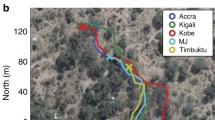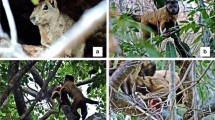Summary
Individually identified lions (Panthera leo) were observed on the open, semi-arid plains in Namibia. Data from 486 coordinated group hunts were analysed to assess cooperation and individual variation in hunting tactics. Group hunts generally involved a formation whereby some lionesses (“wings”) circled prey while others (“centres”) waited for prey to move towards them. Those lionesses that occupied “wing” stalking roles frequently initiated an attack on the prey, while lionesses in “centre” roles moved relatively small distances and most often captured prey in flight from other lionesses. Each lioness in a given pride repeatedly occupied the same position in a hunting formation. Hunts where most lionesses present occupied their preferred positions had a high probability of success. Individual hunting behaviour was not inflexible, however, but varied according to different group compositions and to variations in the behaviour of other individuals present. The role of cooperative hunting and its apparent advantages within the semi-arid environment of Etosha National Park, Namibia, are discussed.
Similar content being viewed by others
References
Ablon SD, Mitchell B, Huby BJ, Brown D (1986) Fertility in female red deer (Cervus elaphus): the effects of body composition, age and reproductive status. J Zool (Lond) 209:447–460
Alcock J (1989) Animal behavior: an evolutionary approach. 4th edn. Sinauer Associates, Sunderland, MA
Anonymous (1989) Laws of the game of rugby football. Freedman & Rossi, Cape Town, South Africa
Bertram BCR (1979) Serengeti predators and their social systems. In: Sinclair ARE, Norton-Griffiths M (eds) Serengeti: dynamics of an ecosystem. University of Chicago Press, Chicago, pp 221–248
Caraco T, Wolf LL (1975) Ecological determinants of group sizes of foraging lions. Am Nat 109:343–352
East R (1984) Rainfall, soil nutrient status and biomass of large Africa savanna mammals. Afr J Ecol 22:245–270
Eaton RL (1970) The predatory sequence with emphasis on killing behavior and its ontogeny, in the cheetah. Z Tierpsychol 27:492–504
Elliot JP, Cowan I McT, Holling CS (1977) Prey capture by the African lion. Can J Zool 56:1726–1734
Griffin DR (1984) Animal thinking. Harvard University Press, Cambridge, MA
Guggisberg CAW (1962) Simba. Bailey Bros & Swinfen, London
Kruuk H (1972) The spotted hyena. University of Chicago Press, Chicago
Lamprecht J (1981) The function of social hunting in larger terrestrial carnivores. Mammal Rev 11:169–179
Le Roux CJG, Grunow JO, Morris JW, Bredenkamp GJ, Scheepers JC (1988) A classification of the vegetation of the Ethosha National Park. S Afr J Bet 54:1–10
Maynard Smith J (1982) Evolution and the theory of games. Cambridge University Press, New York
Mech LD (1970) The wolf: the ecology and behaviour of an endangered species. The Natural History Press, New York
Mills MGL (1990) Kalahari hyaenas: comparative behavioural ecology of two species. Unwin Hyman, London
Norris KS, Schilt CR (1988) Cooperative societies in three-dimensional space: on the origins of aggregations, flocks, and schools, with special reference to dolphins and fish. Ethel Sociobiol 9:149–179
Orford HJL, Perrin MR, Berry HH (1988) Contraception, reproduction and demography of free-ranging Etosha lions (Panthera leo). J Zool (Lond) 216:717–733
Packer C (1986) The ecology of sociality in felids. In: Rubenstein DI, Wrangham RW (eds) Ecological aspects of social evolution. Princeton University Press, Princeton, pp 429–451
Packer C, Pusey AE (1982) Cooperation and competition within coalitions of male lions: kin selection or game theory? Nature 296:740–742
Packer C, Pusey AE (1985) Asymmetric contests in social mammals: respect, manipulation and age-specific aspects. In: Harvey PH, Slatkin M (eds) Evolution: essays in honour of John Maynard Smith. Cambridge University Press, Cambridge, pp 173–186
Packer C, Ruttan L (1988) The evolution of cooperative hunting. Am Nat 132:159–198
Packer C, Scheel D, Pusey AE (1990) Why lions form groups: food is not enough. Am Nat 136:1–19
Schaller GB (1972) The Serengeti lion. University of Chicago Press, Chicago
Scheel D, Packer C (1991) Group hunting behaviour of lions: a search for cooperation. Anim Behav 41:697–709
Siegel S (1956) Nonparametric statistics for the behavioural sciences. McGraw-Hill, New York
Smuts GL, Anderson JL, Austin JC (1978) Age determination of the African lion (Panthera leo). J Zool (Lond) 185:115–146
Smuts GL, Robinson GA, Whyte IJ (1980) Comparative growth of wild male and female lions (Panthera leo). J Zool (Lond) 190:365–373
Stander PE (1991) Demography of lions in the Etosha National Park. Madoqua 18:1–9
Stander PE (1992) Foraging dynamics of lions in a semi-arid environment. Can J Zool (in press)
Slander PE, Albon SD (in press) Hunting success of lions in a semi-acid environment. Symp Zool Soc Lond, vol 65
Stander PE, Morkel PvdB (1991) Field immobilization of lions using disassociative anaesthetics in combination with sedatives. Afr J Ecol 29:137–148
Van Orsdol KG (1981) Lion predation in Rwenzori National Park. PhD thesis, University of Cambridge, UK
Van Wyk TC, Berry HH (1986) Tolazoline as an antagonist in free-living lions immobilized with a ketamine-xylazine combination. J S Afr Vet Ass 57:99–104
Wilson EO (1975) Sociobiology: the new synthesis. Harvard University Press, Cambridge, MA
Author information
Authors and Affiliations
Rights and permissions
About this article
Cite this article
Stander, P.E. Cooperative hunting in lions: the role of the individual. Behav Ecol Sociobiol 29, 445–454 (1992). https://doi.org/10.1007/BF00170175
Received:
Accepted:
Issue Date:
DOI: https://doi.org/10.1007/BF00170175




